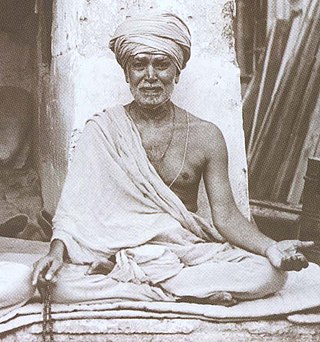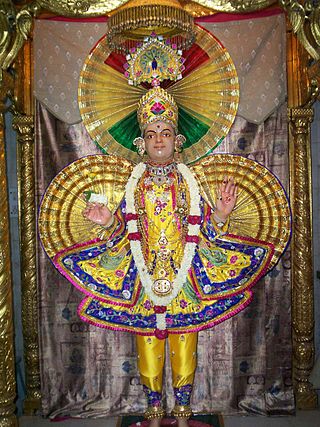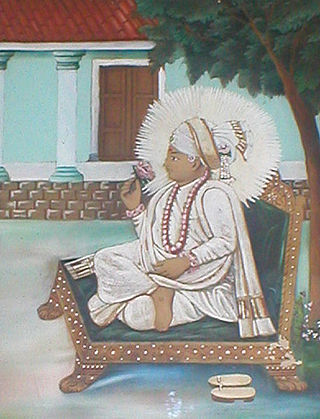
Bochasanwasi Akshar Purushottam Swaminarayan Sanstha is a Hindu denomination within the Swaminarayan Sampradaya. It was formed in 1905 by Yagnapurushdas following his conviction that Swaminarayan remained present on earth through a lineage of gurus starting with Gunatitanand Swami.

Rakeshprasad is a Hindu spiritual leader. He is regarded by the devpaksh faction as the disputed leader of the LaxmiNarayan Dev Gadi. Rakeshprasadji has interests in Sanskrit and Prakrit literature on religion, and that he has established temples and consecrated idols in them.

Swaminarayan, also known as Sahajanand Swami, was a yogi and ascetic, who is believed by followers to be a manifestation of Krishna, or as the highest manifestation of Purushottama, and around whom the Swaminarayan Sampradaya developed.

Gunatitanand Swami, born Mulji Jani, was a prominent paramhansa of the Swaminarayan Sampradaya who was ordained by Swaminarayan and is accepted as the first spiritual successor of Swaminarayan by the Bochasanwasi Akshar Purushottam Swaminarayan Sanstha (BAPS). Born into a religious family in the small farming community of Bhadra in Gujarat, India, he first received religious education under his father's guru, Ramanand Swami, before encountering Swaminarayan and becoming a swami under him at the age of 25. He was revered for his spiritual discourses and divine service.
Nishkulanand Swami (1766–1848) was a paramhansa and swami of the Swaminarayan Sampradaya.

Shastriji Maharaj, born Dungar Patel and ordained Shastri Yagnapurushdas, was a swami of the Swaminarayan Sampradaya and founder of the Bochasanwasi Akshar Purushottam Swaminarayan Sanstha (BAPS). Several branches accept him as the third spiritual successor of Swaminarayan in the lineage of Aksharbrahma Gurus through whom Swaminarayan manifests, which began with Gunatitanand Swami. Born in a family of farmers in central Gujarat, India, he became a swami within the Vadtal diocese of the Swaminarayan Sampradaya at the age of 17 where he was given the name Yagnapurushdas Swami. The prefix Shastri was later added in recognition of his eminent scholarship in Sanskrit and the Hindu scriptures. He established BAPS after a doctrinal split from the Vadtal diocese of the Swaminarayan Sampradaya.

Swaminarayan Mandir, Vadtal headquarters of the LaxmiNarayan Dev Gadi are located in this temple in Vadtal. There are three main shrines in the temple the central shirne of this temple is that of Lakshmi Narayan and RanchodRai. On the right there is idol of Radha Krishna with Swaminarayan in the form of Hari Krishna and the left has Vasudev, Dharma and Bhakti. The wooden pillars of the temple bear colourful wood carvings. There is a dharamsala within the temple premises. Gnyanbaug is a garden to the northwest of the temple gate that has four memorials dedicated to Swaminarayan.

Shri Swaminarayan Mandir, Bhuj is a Hindu temple in Bhuj. This temple was constructed by Swaminarayan, founder of the Swaminarayan Sampradaya.

Tejendraprasad Pande, formally known by his full title as Sanatan Dharma Dhurandar Acharya Maharaj Shree 1008 Tejendraprasadji Maharaj was appointed acharya of the Narnarayan Dev gadi (Ahmedabad) of the Swaminarayan Sampraday, a Hindu sect, by his father, the previous acharya, Devendraprasad, and was enthroned on 13 October 1969.

Acharya Shree Tejendraprasadji Maharaj founded International Swaminarayan Satsang Organization (I.S.S.O.) in the United States on the occasion of Vijaya Dashami in the year 1978.

NarNarayan Dev Yuvak Mandal (NNDYM) was founded by Koshalendraprasad Pande in 1994 with its headquarters at the Kalupur Swaminarayan Mandir (Ahmedabad) and was created to help young people to confront the challenges of life.
The Desh Vibhag Lekh is a document written by Swaminarayan in 1827 establishing the division of the Swaminarayan Sampradaya into two dioceses by territory of Ahmedabad and Vadtal. This document is highly regarded by the two diocese as it establishes Acharyas as the successors to Swaminarayan. Groups that regard sadhus over acharyas downplay the importance of the Lekh as an administrative document.

The Naranarāyan Dēv Gadī, named after the sages Nara-Narayana, is one of the two Gadis (seats) that together form the Swaminarayan Sampradaya. Its headquarter is at the Shri Swaminarayan Mandir, Ahmedabad and controls the Uttar Vibhag.

The Swaminarayan Sampradaya, also known as Swaminarayan Hinduism and Swaminarayan movement, is a Hindu Vaishnava sampradaya rooted in Ramanuja's Vishishtadvaita, characterized by the worship of its charismatic founder Sahajanand Swami, better known as Swaminarayan (1781–1830), as an avatar of Krishna or as the highest manifestation of Purushottam, the supreme God. According to the tradition's lore, both the religious group and Sahajanand Swami became known as Swaminarayan after the Swaminarayan mantra, which is a compound of two Sanskrit words, swami and Narayan.

The Swaminarayan Mandir in Weehawken, New Jersey is the first Swaminarayan temple of the Narnarayan Gadi in the United States. It is the national headquarters of the ISSO and comes under the NarNarayan Dev Gadi of the Swaminarayan Sampraday. Today there are four Swaminarayan temples in New Jersey alone.

Satsangi Jivan is the authorised biography of Swaminarayan. The book contains information on the life and teachings of Swaminarayan. It is written by Shatanand Swami and completed in 1829.Swaminarayan decided to make Gadhada his permanent residence on the insistence of Dada Khachar and his sisters. Upon completion of the Shri Swaminarayan Mandir, Gadhada in 1828, Swaminarayan instructed Shatanand Swami to write a book on his life and pastimes.
The International Swaminarayan Satsang Mandal (ISSM) is a religious organisation of the Hindu faith based in USA. It comes under the Laxmi Narayan Dev Gadi of the Shree Swaminarayan Sampraday. The organisation has temples and centres in various parts of the country as well as a temple in Chicago, Illinois (America).

Koshalendraprasadji Pande is the current acharya of the NarNarayan Dev Gadi of the Swaminarayan Sampraday and is the 7th successor of Swaminarayan in the North Diocese.

Akshar-Purushottam Darshan or Aksarabrahma-Parabrahma-Darsanam, "Akshar-Purushottam philosophy," is a designation used by BAPS as an alternative name for the Swaminarayan Darshana, Swaminarayan's view or teachings, to distinguish it from other Vedanta-traditions. It is based on Swaminarayan's distinction between Parabrahman and Aksharbrahman as two distinct eternal realities, which in this view sets Swaminarayan's teachings apart from other Vedanta-traditions. It is an essential element for the BAPS and it's Akṣara-Puruṣottama Upāsanā ("worship"), in which Purushottam c.q. Parabrahman is present in a lineage of Aksharbrahman guru's, who are the abode (akshar) of God.



















